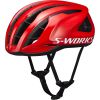Tech Specs: Specialized Prevail 3 MIPS
Retail price: £250.00 / US$300.00 / €290.00 / AU$475.00
Available colours: Black, Vivid Red, White, White Mountains, White/Black, Fjällräven Green, Hyper Dove Grey, White Sage Metallic. Colours may differ by territory
Rotational Impact technology: MIPS Air Node
Weight: 276g as measured in size M
The Specialized Prevail has long been the ventilated lightweight helmet in the American brand’s range and its latest iteration, the Prevail 3, launched in summer 2022 alongside its aero sibling the Evade 3.
As a range-topping helmet in the Specialized lineup, it’s priced at £250.00 (US$300.00 / €290.00 / AU$475.00) and uses innovative technology to find the perfect balance of comfort, safety and performance for riders who want maximum ventilation.
Its biggest draw, even bigger than the abundance of airflow it provides, is that it boasts one of the highest ever scores in the independent helmet testing performed by the facility at Virginia Tech University, one of the very few to test rotational impacts.
I’ve been using the helmet on and off since its launch. It quickly earned a place in our buyer’s guide to the best road bike helmets, but now it’s time to share a detailed run through my experience with it, and how it fares against competitors from the likes of Kask, Bontrager and more.
Design and specifications
Starting with the basics, the Prevail 3 helmet is available in three sizes, in approximately 10 colours, although this differs by territory.
Visually it looks as though Specialized replaced all of the lateral pieces of EPS foam with carbon fibre rods, thus reducing their size and increasing the ventilation, but that’s only half the story.
Moulded into the EPS foam of the helmet is a carbon fibre skeleton called ‘Aircage’ that joins together these rods to create a strong, lightweight shell. Specialized then moulded the EPS foam onto it to create the shape of the helmet and provide direct impact protection.
On the inside, the brand then integrated MIPS ‘Air Node’ attachment points to improve rotational impact protection.
The result is a helmet that, at launch, boasted the highest score in the independent rotational impact testing performed by Virginia Tech with a score of 8.64.
The rear cradle mimics the cradle from other helmets in the Specialized…
Click Here to Read the Full Original Article at CyclingNews RSS Feed…

